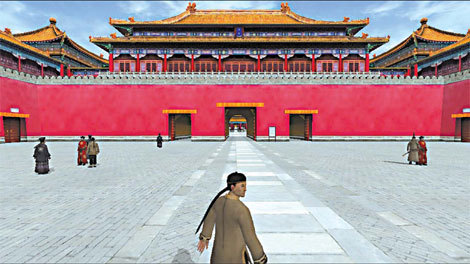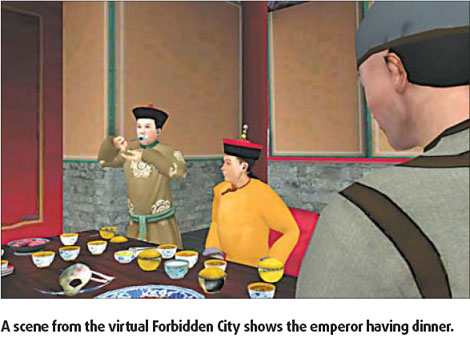|

|
|
The Forbidden City: Beyond Space and Time presents a complete virtual world of the Palace Museum.
|
The Palace Museum has received a unique gift in celebration of its 83rd anniversary, a three-dimensional replica of the walled fortress able to receive any visitor any time.
After three years of development, IBM and the Palace Museum have launched The Forbidden City: Beyond Space and Time, the first complete virtual world created for a major historical and cultural attraction.
The downloadable Forbidden City is at www.beyondspaceandtime.org and can be explored as an avatar, taking visitors into a virtual world.
Virtual charm
The online environment is a fully immersive, interactive world that corresponds architecturally and historically to the vast grounds of the current Palace Museum.
Rather than being a solitary virtual experience, the virtual Forbidden City allows visitors to interact with each other and a wide range of volunteers, staff and automated characters.
Visitors can also experience three-dimensional representations of cultural artifacts and places like the majestic Hall of Supreme Harmony, as well as inspect scenes like "The Emperor Having Dinner" and "Court Painting."

They may also engage in activities in which their avatars take an active role in the culture of the period, including archery, cricket fighting and playing the ancient game of weiqi, now popularized as Go.
They may also take photos, share them with friends, join a group guided tour or even guide a tour.
"We hope this project will help people around the world understand the rich culture of China, its history and its people," says Stanley Litow, president of the IBM International Foundation.
Virtual interest
Completed in 1420 after 12 years of construction, the Forbidden City was created to embody the idea of the emperor as the center of the universe and to evoke a visceral sense of his power. Surrounded by a wall more than 30 feet high and 20 feet thick, the walled fortress once served the emperor exclusively but became "a palace of the people" in 1925 when the Republican forces transformed it into a museum.
Ever since then, people from across the world have flocked to it to explore the splendor of its architecture, culture and history but constraints of distance and cost have limited the number of foreign visitors.